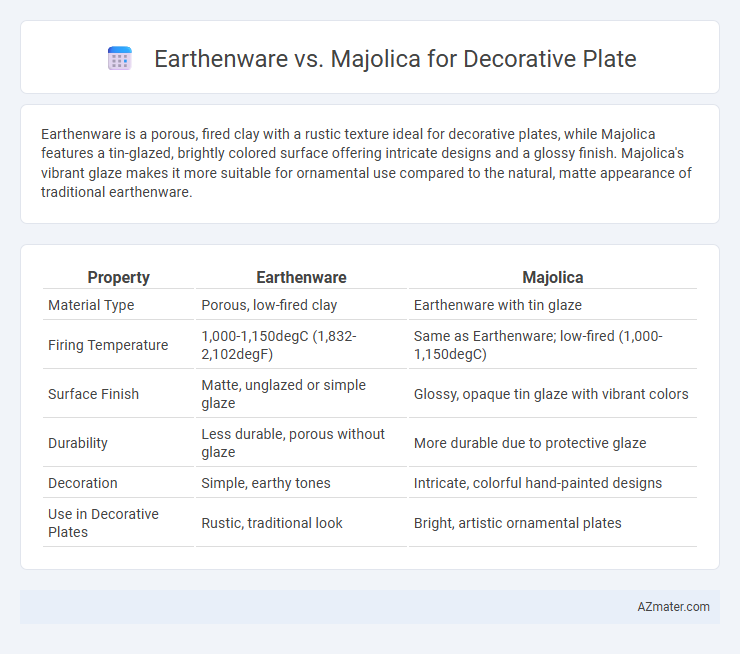Earthenware is a porous, fired clay with a rustic texture ideal for decorative plates, while Majolica features a tin-glazed, brightly colored surface offering intricate designs and a glossy finish. Majolica's vibrant glaze makes it more suitable for ornamental use compared to the natural, matte appearance of traditional earthenware.
Table of Comparison
| Property | Earthenware | Majolica |
|---|---|---|
| Material Type | Porous, low-fired clay | Earthenware with tin glaze |
| Firing Temperature | 1,000-1,150degC (1,832-2,102degF) | Same as Earthenware; low-fired (1,000-1,150degC) |
| Surface Finish | Matte, unglazed or simple glaze | Glossy, opaque tin glaze with vibrant colors |
| Durability | Less durable, porous without glaze | More durable due to protective glaze |
| Decoration | Simple, earthy tones | Intricate, colorful hand-painted designs |
| Use in Decorative Plates | Rustic, traditional look | Bright, artistic ornamental plates |
Introduction to Decorative Plate Materials
Earthenware and majolica are popular materials for decorative plates, each offering distinctive characteristics that influence durability and aesthetic appeal. Earthenware consists of porous, fired clay that is typically thicker and less durable but provides a rustic, traditional look. Majolica, a type of earthenware glazed with a tin-based coating, delivers vibrant colors and intricate details while offering enhanced water resistance and a glossy finish.
What is Earthenware?
Earthenware is a porous, low-fired ceramic material typically fired at temperatures between 1,000degC and 1,150degC, commonly used for decorative plates due to its rich, rustic appearance and ability to absorb vibrant glazes. It is softer and more fragile than stoneware or porcelain but offers excellent versatility in design, often finished with a tin glaze for a smooth, opaque surface characteristic of Majolica. This traditional technique enhances earthenware plates with bright, intricate patterns, making them popular for ornamental use rather than functional dining ware.
What is Majolica?
Majolica is a type of earthenware pottery characterized by its vibrant, glossy tin-glaze that creates a smooth, colorful surface ideal for decorative plates. This technique originated during the Renaissance in Italy and involves applying a white opaque glaze before hand-painting intricate designs, which are then fired to achieve vivid patterns and a lustrous finish. Compared to traditional earthenware, Majolica stands out for its distinct glaze application and highly detailed, ornamental appearance.
Historical Background of Earthenware and Majolica
Earthenware originated thousands of years ago as one of the earliest forms of pottery, characterized by its porous nature and low firing temperature, commonly used in ancient civilizations such as Mesopotamia and Egypt. Majolica, developed during the Italian Renaissance in the 15th century, is a type of earthenware known for its vibrant tin-glazed surface, enabling intricate painted designs and a glossy finish. This historical evolution highlights earthenware's foundational role in ceramic art and majolica's innovation in decorative techniques for ornamental plates.
Key Differences in Production Techniques
Earthenware is fired at lower temperatures between 1,000degC and 1,150degC, resulting in a porous and less durable ceramic body that is often glazed for decoration. Majolica involves a tin-glazing technique where a white, opaque glaze is applied before hand-painting with metallic oxide pigments and firing at slightly higher temperatures around 1,000degC to 1,100degC. The key difference lies in earthenware's simple glazing process versus majolica's intricate tin-glaze and overglaze painting, giving majolica plates their distinctive vibrant colors and glossy finish.
Visual Appeal: Color and Glaze Comparisons
Earthenware decorative plates showcase a warm, rustic appearance with muted colors and a matte or slightly glossy glaze that enhances natural textures. Majolica plates feature vibrant, opaque glazes with intricate hand-painted patterns, offering a glossy, jewel-like finish that intensifies color richness and visual depth. The contrast in glazing techniques results in earthenware's subtle, earthy charm versus majolica's bold, colorful visual appeal.
Durability and Maintenance Factors
Earthenware decorative plates are porous and require sealing to prevent staining and chipping, making them less durable compared to Majolica, which is glazed with a tin-based coating that offers enhanced resistance to moisture and surface wear. Majolica plates maintain vibrant colors longer due to their glazed finish, which also simplifies cleaning, requiring only gentle hand washing without abrasive materials. For long-term durability and ease of maintenance, Majolica is preferred over traditional earthenware in decorative plate collections.
Suitability for Decorative Plate Use
Earthenware offers a porous, rustic texture that is ideal for decorative plates where an artisanal, vintage appeal is desired, while majolica provides a vibrant, glazed finish with intricate hand-painted designs that enhance ornamental value. Majolica's durable glaze protects the artwork and makes it more suitable for display purposes, resisting dust and fading over time. Earthenware plates are best for decorative use in low-traffic areas to avoid chipping, whereas majolica combines aesthetic beauty with functional durability for prominent decorative showcases.
Price and Collectibility Considerations
Earthenware decorative plates typically offer a lower price point due to their porous, less durable material and simpler manufacturing process, making them more accessible for casual collectors. Majolica plates, known for their vibrant glazes and intricate hand-painted designs, usually command higher prices and greater collectibility, especially vintage or limited-edition pieces. Collectors prioritize majolica for its artistic value and rarity, while earthenware is favored for affordability and everyday display.
Choosing Between Earthenware and Majolica for Your Decor
Choosing between earthenware and majolica for your decorative plate hinges on durability and visual appeal; earthenware offers a rustic, matte finish with natural porosity, requiring sealing to prevent moisture damage. Majolica stands out with its vibrant, glossy glaze and intricate hand-painted designs, making it ideal for adding colorful, artistic flair to your decor. Prioritize majolica for statement pieces showcasing detailed patterns, while earthenware suits understated, earthy interiors needing a warm, organic texture.

Infographic: Earthenware vs Majolica for Decorative Plate
 azmater.com
azmater.com